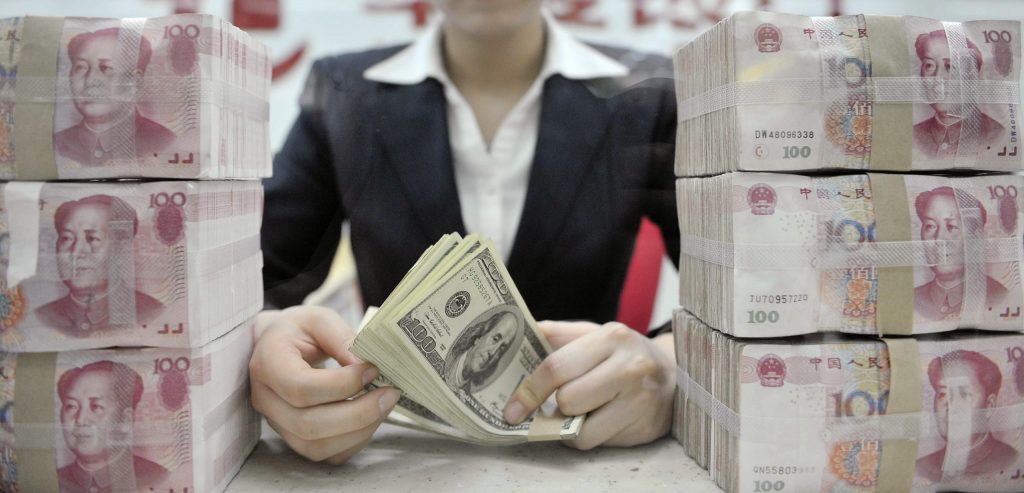Editor’s note: China’s Central bank has management of exchange rates and the current account balance as part of its job. Our central bank does not. Our market access charge bill would change that, adding exchange rate management to the Fed mandate with tools to achieve a current account (trade) balance. Federal reserve staff has wrongly stated that an exchange rate management mandate may conflict with other mandates, but China does not believe that. They handle it just fine for the benefit of their economic strategy. They simply will not be allowing a trade deficit as we do. We fight with one hand tied behind our back. They fight with many hands.
Any hopes that the Chinese central bank’s latest step to support the economy would cheer its battered domestic stock market were dispatched roughly when trading resumed after a week-long holiday. The Shanghai Composite Index plunged nearly 4 per cent on Monday, the biggest one-day fall in nearly four months.
Thankfully, propping up share prices is not among the current policy priorities of the People’s Bank of China (PBoC). However, the bank has committed to maintaining both exchange rate and interest rate stability, a balancing act that the monetary authority will find increasingly difficult to manage in the months ahead as domestic and external pressures increase.
Something will eventually have to give, and we expect the PBoC to let the renminbi weaken rather than try to defend the currency and risk a sharp slowdown in the domestic economy. To Donald Trump, this would look as though China was weaponising the exchange rate to support exporters, but it would really be a byproduct of looser monetary policy.
Still fine-tuning
The fourth reserve requirement ratio cut this year, announced at the weekend, will release around Rmb750bn ($108bn) in commercial bank deposits back into the system when it goes into effect on October 15.
The PBoC says these funds are not intended as outright stimulus. As parts of the economy struggle under the constraints of the government’s austerity push and an increasingly rocky external situation, the authorities hope that pumping in more liquidity will bring relief to starved small/private enterprises and help keep debt defaults under control. More cuts could be in the offing; once this latest adjustment takes effect, the reserve ratio for China’s biggest banks will be at 14.5 per cent, a near-11 year low but part of around Rmb20tn in required reserves sitting with the PBoC.
Officials insist at every turn they will not resort to outright stimulus, such as that seen in 2008 and 2015, when interest rates were slashed to support the economy. However, pressure is mounting internally for a more forceful response to the domestic slowdown and to the White House’s economic broadsides.
The bank’s monetary policy committee, which meets in an advisory capacity, most recently committed to maintaining a balance between interest rates, the exchange rate and the balance of payments. While the PBoC has been reasonably successful in fulfilling this mandate, past performance is no guarantee of future results and trade-offs will have to be made if growth slows further.
Where the PBoC has exerted control over the exchange rate, the intention has been less to stop depreciation outright — it has fallen as much as 10 per cent against the dollar this year — than to manage the pace of the fall. The tightening of capital controls in 2015 and 2016 has helped keep depreciation pressure under control, while portfolio inflows have also helped. But the Federal Reserve is continuing to tighten US monetary policy, reducing the attractiveness of holding renminbi relative to the dollar, increasing outflow pressure and depreciation pressure on the Chinese currency.
Gathering clouds
Ideally, economic growth will hold up and give the central bank room to hold the line on monetary policy. Under this scenario, it may even be able to increase interest rates slightly to help keep the exchange rate stable.
However, growth is likely to slow more than is suggested by the central bank’s current policy path. The impact of the trade war has yet to show up in the data but may start to do so early in 2019. When it does, it will compound the effects of financial deleveraging, tighter controls on local government debt and restrictions on the property sector, which have all worked to constrain the drivers of China’s debt-driven growth model. The government will hit this year’s 6.5 per cent GDP growth target but may be unable to repeat the trick in 2019.
At this point, the PBoC’s challenge in managing interest rates and the exchange rate would become impossible, particularly if the US Federal Reserve continues raising rates into 2019. The Chinese central bank would have to loosen monetary policy more aggressively, including through lower interbank market rates, if not benchmark lending and deposit rates.
Ultimately, the limits of monetary policy in supporting the Chinese economy are once again on display. Rather than reserve ratio cuts, China needs more aggressive reforms to encourage consumption. This would help to rebalance the economy, boost confidence and lure in more capital, alleviating exchange rate pressure.
In its weekend announcement, the central bank insisted that the reserve cut was intended to “optimise the structure of liquidity without easing monetary policy” and therefore would not pressure the exchange rate. But as the bad news builds, it will become increasingly difficult to make this claim.













